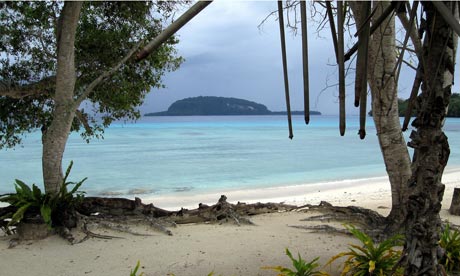
Vanuatu, a series of more than 300 volcanic Pacific islands, radiates with glorious colour and diverse wildlife
It looks like suicide. Hurling themselves one by one from the top of a 27-metre homemade scaffold, with nothing but two springy vines tied to their ankles, the boys and men of Pentecost Island perform a necessary ritual. They plummet through the air with breathtaking grace, some leaping for the first time as part of a rite of passage into manhood, others jumping with an air of practised finesse. But not one land-diver performs his duty with anything less than the utmost respect, for it is upon this performance that the yield of the coming year’s yam harvest depends.
Some might argue that they are right to appease the land. The cluster of more than 300 Pacific islands, islets and protruding rocks that makes up the archipelago of Vanuatu sits upon one of the most volatile fault-lines in the world, the Ring of Fire. There are nine volcanoes throughout the islands, and as a direct result of all the seismic activity, new land is constantly being created.
Yet Vanuatu is not just the location of dramatic shifts in the earth’s plates, but also a land of rare natural beauty, home for a diverse collection of plants and animals both on land and under water. The fertile volcanic soil is a breeding-ground for plants such as the majestic banyan tree, whose crown can reach a span of up to 70 metres or more, and, in this lush habitat, a host of indigenous birds and mammals thrive.
The coral ridges that thread between the islands teem with marine life, supporting over 450 species of reef fish and providing magical playgrounds for sea turtles. Beyond the enclosure of the reefs, porpoises and dolphins swim in the open ocean along with sharks and flying fish.
The indigenous people of Vanuatu, the ‘ni-Vanuatu’, are descended from the intrepid Melanesian and Polynesian migrants who crossed the South Pacific centuries ago in wooden sailing canoes. The name Vanuatu means ‘our home’, but for several centuries the country was known by the name that Captain James Cook gave it upon his arrival in 1774 – the New Hebrides. Vanuatu took back its original name in 1980 when it gained independence from the UK and France.
There are three official languages – Bislama (a pidgin of English), English and French, but at least 105 distinct indigenous languages are also spoken throughout the islands, and the traditions and social customs of the inhabitants vary as much as their languages as one moves from place to place.
Although urban ni-Vanuatu have adopted western clothing, there are still villages where the traditional ways of life are preserved, and, when the city-dwellers return to their rural homesteads, the males don their customary nambas or penis wrappers, while the females dress in skirts made from grasses.
The south-eastern corner of Tanna Island is dominated by the active volcano Mount Yasur, which is without doubt one of the most impressive and accessible displays of the sheer power of the earth. Peering over the edge of the dark crater, it is possible to see three vents alternately spitting jets of smoke and molten rock; your ears adjust to the deafening hissing and spluttering when, without warning, the ground thunders beneath you, and a pillar of molten lava sprays up out of the crater and shoots into the night sky. There is no protection, no shelter, nothing between you and the flying hot boulders – and the feeling of exposure is awe-inspiring.No wonder the volcano has become the focal-point for a large proportion of indigenous folklore. In the local language yasur means ‘old man’, and traditionally he is the Origin of the Universe. The south-eastern Tannese believe that the spirits of their dead are contained within the volcano, simultaneously in heaven and hell, while followers of the mysterious John Frum cult believe that John Frum lives inside the volcano along with a huge army of anywhere between 5,000 and 20,000 men or spirits.
No-one knows who John Frum actually was – there are at least six theories – but according to the faithful, John Frum came from the sea at Green Point and announced himself to some kava drinkers, telling them that there would be wealth and an end to epidemics that had haunted the islanders since the arrival of the Europeans. However, there is one condition which has to be fulfilled before John Frum’s prophecy will come true – all Europeans have to leave the island.
Tannese rituals are numerous and elaborate in the few villages where customs dominate the way of life. Men wear their traditional nambas while the women dress in grass skirts, and ceremonies like the Nekowiar are performed. The Nekowiar is a huge, three-day party in which the hosting village must try to give its guests lots of impressive gifts of the finest quality. A few weeks later, the guest village will hold a party of its own to which it will invite its neighbour, competing to give bigger and better presents back. It is a contest of generosity, for according to Tannese custom, generosity is a status symbol – the more powerful and wealthy you are, the more you have to give to others.
Adapted by Polly Riley-Smith from Vanuatu: A Lonely Planet Travel Survival Kit